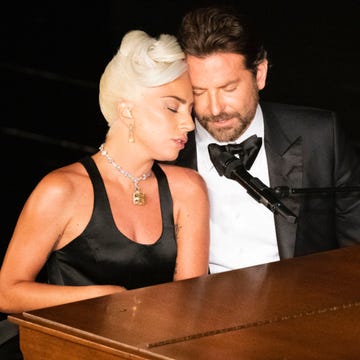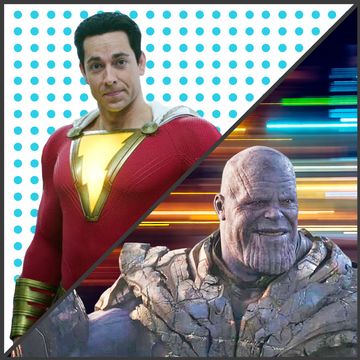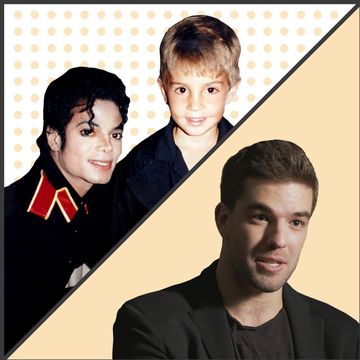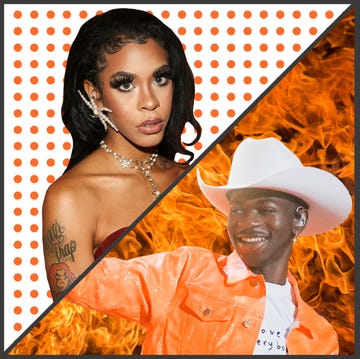The Best Movies of 2019
From black-and-white nautical madness to Brad Pitt in space (and the '60s), this is the greatest cinema of the year.

The end is here, at least for the cinematic year, which has gifted us with a bounty of audacious dramas, documentaries, comedies, thrillers and action-adventures. From crowd-pleasing blockbusters to under-the-radar triumphs, eclectic imports to boundary-pushing epics (we’re looking at you, The Irishman), there’s been something for everyone at the theater – and, also, on the various streaming services that now compete for cinephiles’ attention. The Oscar season may be just kicking into high gear, but at Esquire, we’re ready to crown the year’s 50 (!) standouts. Which is exactly what we’ve done here, in the final installment of our rundown of the Best Films of 2019.
50. Her Smell
Elisabeth Moss gets her riot-grrrl on in Her Smell, delivering a tour-de-force performance of rampant egomania and self-destruction that galvanizes Alex Ross Perry’s film. A mid-‘90s Courtney Love type who resides in the center of a tornado of her own making, Moss’ Becky Something leaves only chaos in her wake, much to the chagrin of her bandmates (Agyness Deyn and Gayle Rankin), ex (Dan Stevens), young daughter (Daisy Pugh-Weiss), mother (Virginia Madsen), collaborators/rivals (including Amber Heard and Cara Delevingne) and heroically loyal manager (Eric Stoltz). Split into five chapters that are interlaced with flashback home videos of happier early times, Perry’s tale traces Becky’s journey from apocalyptic drugged-out collapse to cautious resurrection, his handheld camera exactingly attuned to his protagonist’s scattershot headspace. There’s a vicarious thrill to watching this rocker spiral into the abyss, and then pull herself back out. While Moss doesn’t hold back in depicting Becky’s ugliness, she taps into the underlying hurt and vulnerability fueling her firestorm heart, peaking with a heart-rending single-take piano rendition of Bryan Adams’ “Heaven.”
49. The Dead Don’t Die
Jim Jarmusch crafts an undeadpan comedy of apocalyptic proportions with The Dead Don’t Die, a Night of the Living Dead riff played for bleak satire. In the “nice” town of Centerville, chief Cliff (Bill Murray) and officer Ronnie (Adam Driver) are forced to contend with a zombie outbreak caused by…well, maybe it’s the polar fracking that’s knocked the Earth off its axis, or the MAGA-type insanity peddled by local farmer Frank (Steve Buscemi), or simply good ol’ fashioned American materialism. “This isn’t going to end well,” warns Ronnie at regular intervals, which he knows because he’s read Jarmusch’s script – just one of many instances in which the film indulges in goofy self-referentiality. A stellar cast that also includes Chloë Sevigny, Larry Fessenden, Danny Glover, Selena Gomez and Tom Waits (looking like a reject from Cats) go through their end-of-the-world motions with laid-back confusion and panic (they’re barely animated themselves). Meanwhile, Jarmusch stages scenes of gruesomeness with a shrug-ish good humor that belies this simmering-with-anger critique of a world going, perhaps deservedly, to hell.
48. Fast Color
“If something’s broken, it stays broken,” intones Bo (Lorraine Toussaint) at the outset of Fast Color, which then proceeds to show that things – and people – can be mended through the power of family, love and connection to the past. Director Julia Hart’s sophomore feature (co-written with Jordan Horowitz) is an unconventional superhero saga about Ruth (Gugu Mbatha-Raw), who in a near future decimated by lack of rain, flees government agent Bill (Christopher Denham) while trying to control her extraordinary abilities, which manifest themselves as seismic seizures. Ruth’s flight takes her to her childhood home and her mom Bo (Lorraine Toussaint) and daughter Lila (Saniyya Sidney), both of whom have the capacity to wield swirly-colored constructive/deconstructive energy. The volatility of youth and the vitality of kinship (with present and former relatives) serve as sturdy thematic undercurrents for this low-key genre tale. Far more subdued than its summer-blockbuster brethren, it’s a showcase for Hart’s vibrant visuals and Mbatha-Raw’s heartfelt performance as a woman finding strength not from independence but, instead, from bonds of blood.
47. Skin
Jamie Bell gives the performance of his career as Bryon “Babs” Widner, a face-tattooed neo-Nazi contending with his chosen white-power path, in Oscar-winning director Guy Nattiv’s based-on-real-events tale of the origins of hate – and the potential means of reversing it. Indoctrinated from a young age by his surrogate-parent gang leaders (Bill Camp and Vera Farmiga), Widner preaches xenophobia and division until he meets single mother Julie (Danielle Macdonald). Her love, and the promise of a healthier sort of family, compels him to reconsider his life choices. A portrait of the arduousness of transformation and redemption, Skin shares direct, unsettling ties to our current geopolitical moment. Affording no easy solutions to the problems it presents, it’s a micro examination of a macro crisis, made transfixing by Bell’s warts-and-all embodiment of intolerance – a learned ethos rooted in issues of anger, insecurity and isolation, and correctable (if at all) only through a combination of pain and sacrifice.
46. It Chapter Two
Now adults played by the likes of James McAvoy, Jessica Chastain and Bill Hader, The Losers Club returns to Derry, Maine to again confront unspeakable evil in It: Chapter 2, Andres Muschietti’s sprawling, character-driven companion piece to his 2017 blockbuster. As before, that enclave’s malevolence is personified by Pennywise the Dancing Clown (Bill Skarsgård), an unholy sewer-dwelling circus freak who feasts on fear, and whose hunger for revenge powers the film’s finest set pieces, including a showdown in a hall of mirrors. What truly elevates Muschietti’s sequel, however, is its focus on the efforts of its now-grown protagonists to conquer the anxieties, doubts and regrets that, following their childhood ordeal, have come to define them. Segueing between time periods, it’s a spookshow study of the grip that the past holds over the present, the vital – and often corrosive – means by which memories affect our worldview and sense of self, and a touching ode to the power of togetherness. Paired with its predecessor, it’s one of the finest Stephen King adaptations ever.
45. Dolemite is My Name
Eddie Murphy regains his superstar mojo in Dolemite is My Name, a raucous biopic fashioned in an Ed Wood and The Disaster Artist mold (from the writers of the former) about Rudy Ray Moore, a clownish wannabe-entertainer who hit it big by playing the profanely rhyming, kung-fu-fighting, ladies-bedding Dolemite. It’s been decades since Murphy has been this hilariously energized, his giant smile and brash talk elevating this underdog-makes-good effort from Craig Brewer (Hustle & Flow), which traces Moore’s transformative creation of both his famous alter ego, as well as the family of friends and collaborators who helped him realize his stage and screen dreams. Decked out in a variety of swanky colorful suits (replete with matching hats), and wielding a cane that aids his strut, Murphy turns Moore’s story into his own declarative statement of peerless comedic bravado – and he needs every ounce of that charisma to keep the spotlight on himself, because as Moore’s director/co-star, a bug-eyed, flamboyantly mannered Wesley Snipes almost steals the film from him.
44. Tigers Are Not Afraid
With Tigers Are Not Afraid, writer/director Issa López conjures a modern fairy tale rooted in traumas of both a personal and political nature. In a Mexican city rendered a ghost town by violent drug gangs, young Estrella (Paola Lara) strikes up a prickly alliance with a group of orphaned boys – led by Shine (Juan Ramón López) – after her mother goes missing. Convinced the three chalk pieces she received from her teacher grant her magical wishes, Estrella tries to survive her harrowing new circumstances on the streets, which are further complicated by two adult thugs intent on reclaiming their stolen property from Shine. Pitched in fantastical Grimms terms (with a dash of Guillermo Del Toro), López’s allegorical feature doesn’t shy away from the brutal realities of its scenario, often to heartrending effect. It casts a spell through malevolent horror imagery as well as its moving portrait of kids banding together to form a makeshift clan – and, in the process, to courageously face a world intent on destroying them, physically and psychically, at every turn.
43. One Cut of the Dead
Shin’ichirô Ueda’s cult classic-in-the-making is about a couple fending off a zombie plague. Until, that is, it reveals itself to be about a crew of filmmakers making an undead horror movie. And then, it becomes a story about how those artists are in fact overrun by a real zombie threat. Which – believe it or not – isn’t the final twist in One Cut of the Dead, a rollicking comedy that keeps viewers on their toes by constantly divulging new layers of reality. Kicking off with a bravura 37-minute single take sequence that charts its characters’ attempts to navigate their monstrous ordeal – all as their director, Higurashi (Takayuki Hamatsu), continues to roll cameras – the film eventually delivers a meta bombshell that totally reconfigures one’s conception of the action at hand. More importantly, that revelation repositions the material’s focus onto the art of moviemaking itself, and the myriad headaches – caused by temperamental actors, budget constraints and unforeseen delays and obstacles – common to the process. Think of it as a ghoulish Day for Night.
42. Invisible Life
Invisible Life is comprised of well-worn elements: impulsive passions, unexpected out-of-wedlock pregnancies, disapproving fathers, controlling husbands, and dreams crushed under the weight of a society that expects women to conform or be cast out into the wild. Yet despite their familiarity, such building blocks prove the stuff of superior melodrama in the hands of Brazilian-German director Karim Aïnouz, whose adaptation of Martha Batalha’s 2016 novel pays heartbreaking tribute to the strength, solidarity and unjust suffering of two sisters – reckless young Guida (Julia Stockler) and older would-be pianist Euridice (Carol Duarte) – who are torn apart by their callous dad (António Fonseca), Euridice’s chauvinistic spouse (Gregorio), and their patriarchal Brazilian culture. Foreshadowing his protagonists’ decades-long plight in a haunting allegorical intro, and then mining their pain and longing in empathetic close-ups, Aïnouz captures the inherently political nature of these siblings’ personal experience. Good luck maintaining a dry eye through its wrenching present-day coda.
41. I Lost My Body
I Lost My Body has a horror movie conceit, but the true terror of Jérémy Clapin’s ingenious animated film is of an existential nature. In a refrigerator, a disembodied hand awakens, and embarks on a quest to reunite with its former owner, who we soon learn is Moroccan-born French teenager Naoufel (voiced by Hakim Faris). A trifurcated tale split between the hand’s journey, Naoufel’s pre-accident life as a pizza delivery boy, and his early adolescence, Clapin’s two-dimensional gem is an arresting aesthetic experience, its daring visuals married to a soundscape of buzzing, barking and screeching that lends the action an immersive immediacy. Overflowing with symbolic motifs and twirling movement, it’s a philosophical inquiry into fate, agency, trauma and love – and the state of being whole, figuratively and literally – that, to its benefit, refrains from positing concrete answers to its profound questions. With Dan Levy’s score melding electronic and orchestral arrangements to intoxicating effect, it’s a sensory feast into which one tumbles.
40. American Factory
The rapidly changing global manufacturing landscape is examined through the lens of an Ohio auto-glass plant founded by the Chinese and staffed with men and women from both countries in American Factory. The first release to emerge from the Obamas’ production deal with Netflix, Julia Reichert and Steve Bognar’s eye-opening documentary begins on a high, as American and Chinese workers show equal enthusiasm for the new venture, which promises to bring opportunity (and, hopefully, prosperity) to a community hit hard by a prior GM plant’s closing. Various culture-clash issues, however, soon complicate the endeavor’s chances for success, leading to tensions on both sides and, ultimately, a battle over workers’ desire to unionize, which is opposed by their foreign-born bosses. Plumbing American and Chinese expectations and attitudes regarding labor, as well as the compatibility of the two countries’ ways of doing things, it’s an intimate on-the-ground look at 21st-century globalization in practice.
39. The Burial of Kojo
Musician-filmmaker Blitz Bazawule’s feature debut is a spellbinding storybook fable about a young Ghanaian girl named Esi (Cynthia Dankwa) whose father Kojo (Joseph Otsiman) is convinced by his back-in-the-picture brother Kwabena (Kobina Amissah-Sam) to move their family from a village on stilts in the middle of a lake to the big city, where greater economic prosperity supposedly awaits them. As conveyed by Esi’s encounter with an old blind man – who says he’s from an upside-down purgatory, and tells her to protect a bird from an evil crow – and the sibling rivalry-centric soap opera that Esi watches with her grandmother (Joyce Anima Misa Amoah), The Burial of Kojo is a story about reunion, loss and reconciliation that exists somewhere between reality and fantasy. Bazawule’s slow-motion imagery is mesmerizing, highlighted by the inverted sight of Esi being chased by a humanoid raven astride a horse, and a closing shot of an man with an IV stand meeting a long-lost love in the middle of architectural ruins. There’s poignant poetry in this haunting fairy tale, and magic as well.
38. The Great Hack
Cambridge Analytica stole the data of 87 million Facebook users and then utilized it to target swing voters with political propaganda on behalf of clients like Brexit and the 2016 Trump campaign. And yet somehow, that villainous firm isn’t even the most vile player in The Great Hack, since that goes to Facebook, which not only collaborated with Cambridge Analytica (and failed to control it), but also allowed itself to become the preeminent platform for wide-scale, democracy-undermining disinformation operations. With both dynamism and comprehensiveness, Karim Amer and Jehane Noujaim’s infuriating documentary details the Cambridge Analytica scandal via the work of reporters and whisteblowers intent on exposing the company’s function as a tool of right-wing extremists both in America and abroad. In doing so, it reveals a terrifying digital new world order where data is the most valuable commodity, as well as the key to conducting psychological warfare on a heretofore unheard-of scale. It’s the horror film of the year.
37. Plus One
Weddings can be a torturous drag for singles, so longtime friends Alice (Maya Erskine) and Ben (Jack Quaid) decide to spend their overbooked nuptials season tag-teaming events as platonic dates. Jeff Chan and Andrew Rhymer’s romantic comedy is, per formula, bound to have its seemingly opposite protagonists discover their attraction for one another, yet predictability is of no concern when the amorous action is as consistently funny and charming as it is in this jaunty indie. Be it stumbling their way through one ceremony and party after another, or embarking on their own unlikely relationship while dealing with their troublesome parents, Alice and Ben prove to be excellent company, she using booze and a sharp tongue to cope with her loneliness, and he clinging to high standards as a way to avoid commitment and stave off potential abandonment. Erskine in particular is a revelation – a charismatically uninhibited riot, she seems destined for Hollywood’s A-list.
36. Crawl
As mean, and quite a bit leaner, than its voracious animals, Crawl is an example of B-moviemaking done right. During an apocalyptic Florida hurricane, struggling but talented collegiate swimmer Haley (Kaya Scodelario) goes in search of her MIA father Dave (Barry Pepper), whom she finds in the basement of their old home, wounded and trapped by a swarm of alligators. Their confined setting is a veritable labyrinth that –as with CGI-ified imagery of storm-ravaged communities – director Alexandre Aja imbues with underlying allegorical heft. That only bolsters his suspenseful storytelling, characterized by formidable set pieces – involving perilous aquatic races against, and bone-crunching tussles with, the wild beasts – that further reflect Haley and Dave’s strained father-daughter dynamics. A trip to the gators’ egg-laying nursery is a particular highlight, although singling out one of the film’s showstoppers seems almost unfair. From start to finish, Crawl is the sort of edge-of-your-seat, cringing-with-delight thriller that Hollywood rarely makes these days.
35. Burning Cane
God and the Devil are at war in rural Louisiana in Burning Cane, and the former doesn’t appear to be faring too well. Whether it’s fiery Reverend Tillman (Wendell Pierce) or despondent unemployed Daniel (Dominique McClellan), Satan has infected the hearts and minds of this cane field-saturated area’s men, leaving women to suffer often-fatal blows and children – namely, Daniel’s young son Jeremiah (Braelyn Kelly) – to quietly go to seed, their corruption all but inevitable. Made by first-time writer/director Phillip Youmans at the age of 19, the film imparts an all-encompassing sense of its milieu’s atmosphere, from the oppressive stillness of the air, to the spartan sounds of insects and footsteps in partly furnished old homes, to the sticky countenances that dot the swampy landscape. At the center of this evocative drama is Daniel’s mother Helen (Karen Kaia Livers), caught between her religious convictions and the harsher, contradicting realities around her. Long-suffering but resolutely defiant, she’s the embodiment of female perseverance in the face of the unholy.
34. Ad Astra
For all its operatic echoes of 2001, Apocalypse Now and The Tree of Life, James Gray’s Ad Astra is a distinctive vision of the grand abyss lying beyond our planet, as well as an affecting investigation into man’s longing for communion. In the near future, Major Roy McBride (Brad Pitt) is sent on a top-secret mission to Neptune, where his commanders believe his renowned father Clifford (Tommy Lee Jones) – missing for decades on a quest to find intelligent E.T. life– is alive, and causing intergalactic pulses that threaten Earth. His quest is fraught with literal danger and, also, emotional, psychological and spiritual peril, as Roy searches the heavens for the indifferent father that abandoned him. Brought to life by Pitt with a wellspring of bubbling-beneath-the-surface pain, yearning and hope, Roy is a man whose steady pulse rate is emblematic of his sorrowful, walled-off remoteness. Led by his own interior-thought narration, Roy’s saga is at once awe-inspiring and poignant, intimate and majestic.
33. Ford v Ferrari
James Mangold’s Ford v Ferrari may not redefine its field in the way that the Ford GT40 revolutionized auto racing, but it’s nonetheless a muscular example of big-budget, star-driven Hollywood entertainment. Elevating its conventional storytelling through mega-watt personality and fast, screeching track action, Mangold’s based-on-real-events film rides alongside former champ Carroll Shelby (Matt Damon) and his rough-around-the-edges driver Ken Miles (Christian Bale) as they attempt to build a car for Henry Ford II (Tracy Letts) capable of besting Ferrari’s legendary vehicles in 1966’s 24-hour Le Mans contest. Mangold’s story is about the might of American ingenuity and daring (versus sleek Italian arrogance), and a celebration of non-conformity in the face of (unbeatable) corporate pressure. Its rah-rah renegade spirit is as robust as its racing footage, often shot from the driver’s inside-the-car POV. Better still, this blistering ode to rubber-burning independence and individuality also gives Miles – a wheelman of unparalleled audaciousness and skill – the rightful due he was denied decades earlier.
32. Tell Me Who I Am
If our memories aren’t truly our own, how do we know who we are? Such was the profound existential crisis faced by 18-year-old Alex Lewis when, in 1982, he was injured in a car accident, lapsed into a coma, and awoke to find that he recognized no one save for his twin brother Marcus. That afforded Marcus an opportunity to rebuild his sibling with stories about their past – some of which omitted crucial events from their horrendous childhood. With acute empathy and formal eloquence, director Ed Perkins investigates this shocking tale from the perspectives of both brothers, whose bond was forged by love and trust, and torn asunder by deception and betrayal. What emerges is a complex story about truth, lies and silence, the last of which is the real evil force in both Alex and Marcus’ life – concealing the horrors committed against them as kids, and tearing them apart as adults, at least until Perkins’ documentary stages a face-to-face sit-down rife with bitterness, regret and understanding.
31. The Last Black Man in San Francisco
The story of two friends who, like their hometown, are in a state of uneasy transition, The Last Black Man in San Francisco affords narrative and aesthetic surprises around every corner. For skateboarding Jimmie (Jimmie Fails), nothing would be finer than reclaiming his childhood residence, a gorgeous Victorian in the Fillmore District that he proudly proclaims was built by his grandfather. Jimmie’s awkward aspiring-playwright pal Mont (Jonathan Majors) goes along with his plan to move into the abode once the current tenants are forced to leave (over an estate dispute) – an act of squatting that doubles as an attempt at reclaiming a cherished past. In his debut feature, director Joe Talbot populates Jimmie and Mont’s story with childhood friends and estranged relatives whose presence, or absence, speaks to the story’s underlying strains of cultural-racial-familial disaffection, troubled identity, and longing for home. With a lyrical touch that invigorates his often-droll action, Talbot pays bittersweet tribute to San Francisco and the magic of true friendship.
Watch Next


The 60 Best Movies to Stream on Amazon Prime Video

The 10 Best Television Episodes of 2019

The Sexiest Movies of 2019

The Best Netflix Series of 2019







